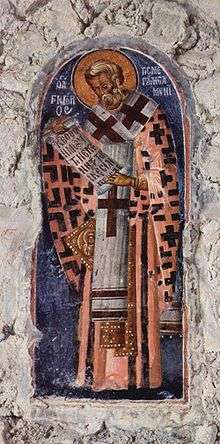Epigonation
The epigonation (Greek: ἐπιγονάτιον, literally meaning "over the knee"), or palitza (Russian: палица, "club"), is a vestment used in some Eastern Christian churches.
.jpg)

Description and usage
In Eastern Orthodoxy and Eastern Catholic Churches which follow the Byzantine Rite the palitza is worn by all bishops, and as an ecclesiastical award for some priests.[1]:xxxviii Its origin is traced to the practice of Byzantine Emperors awarding ceremonial swords to their military commanders in recognition of their valour in defending the empire. Such swords were often accompanied by elaborate thigh-shields which were suspended from the belt and protected the leg from bruising caused by the constant bumping of the sword against the thigh. When the emperors began to give awards to the clergy, the thigh-shield alone was awarded.[2]
The vestment is a stiff, lozenge shaped cloth that hangs on the right side of the body below the waist, suspended by one corner from a strap drawn over the left shoulder. In the Russian tradition it is an award for service; in the Greek tradition it is usually a sign that the priest has an advanced academic degree and a blessing to hear confessions. If a Russian priest has been awarded both the nabedrennik and the palitza, he shifts the former to the left side. It is considered to symbolise the "sword of the Spirit, which is the Word of God" (Ephesians 6:17); that is to say, the wearer's defending of the faith by smiting all that is impure and vicious.[2]
Upon donning his palitza, the cleric prays: "Gird thy sword upon thy thigh, O Mighty One, in thy comeliness and thy beauty; and exert, and fare Thee well, and reign in the name of truth, and of meekness, and of justice; and Thy right hand shall guide Thee wondrously. Now and ever, and unto the ages of ages. Amen".
History
The epigonation's origin is uncertain. According to some authorities it was a decorated tablion or thigh-shield awarded to officials in the Byzantine Empire, originally military and later civilian. According to others it was originally an ornamental handkerchief, called at that date encheirion, "hand cloth", which received its present form and name in the twelfth century. In the former case it has no Western Christian counterpart; in the latter it would correspond to the Sub-cinctorium, used by Roman popes in solemn masses.
It is also said that it was used to carry documents relating to one's position in the Church. Papers such as those certifying one's ordination and rank would be most relevant when travelling. Carrying them in the Liturgy would be symbolic of bearing one's authority to conduct the Holy things of the Liturgy.
During the Mystery (Sacrament) of Ordination, a priest or deacon is taken in procession three times around the Holy Table (altar), after each circuit he bows down before the bishop and kisses his epigonation and his right hand.[1]:311 Also, in some liturgical traditions, when a bishop performs a lesser ordination, such as the setting-apart of a subdeacon, he lays his epigonation over the candidate's head as he says the prayer.
Armenian usage
The gonker (epigonation) is used exclusively by the two Catholicoi of the Armenian Apostolic Church and is granted occasionally with special authorization to patriarchs.[3] The Catholicos of the Armenian Catholic Church also wears it, although it does not appear to be exclusive to him. The recently ordained archbishop for the Armenian Catholic Archeparchy of Constantinople wore a gonker at his ordination.[4]
An image of Saint Blaise of Sebaste in the Armenian Catholic parish of San Nicola da Tolentino in Rome depicts the saint wearing a gonker.[5]
References
- Hapgood, Isabel Florence (1922). Service Book of the Holy Orthodox-Catholic Apostolic Church (Revised ed.). New York: Association Press.
- Sokolof, Archpriest D. (1917), A Manual of the Orthodox Church's Divine Services (3rd (re-edited) ed.), Jordanville NY: Printshop of St. Job of Pochaev, Holy Trinity Monastery (published 2001), pp. 32–33
- "Vessels and Vestments: D through H". The Armenian Church.
- http://armenianchurchco.com/wp-content/uploads/2014/09/zekiyan2takdis.jpg
- http://mechitar.com/pic/big/01_02_38.jpg
Sources
- Braun, Joseph (1913). . In Herbermann, Charles (ed.). Catholic Encyclopedia. New York: Robert Appleton Company.
- Braun, Joseph (1913). . In Herbermann, Charles (ed.). Catholic Encyclopedia. New York: Robert Appleton Company.